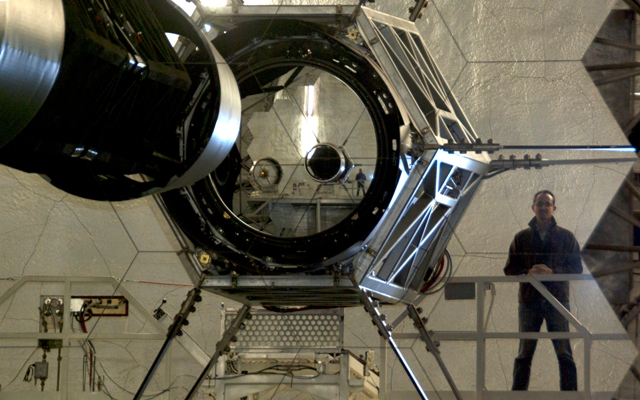Sep 17 2013
Astronomers at the University of California, Riverside have received a three-year grant from the National Science Foundation to conduct a very large new survey of galaxies using a new instrument — MOSFIRE — on the Keck I telescope at the summit of Mauna Kea on Hawai’s Big Island.
 The reflection of Brian Siana in the primary mirror of the Keck telescope. The telescopes’ mirrors are made of 36 hexagonal segments. Photo credit: Barbara Schaefer, Keck Observatory.
The reflection of Brian Siana in the primary mirror of the Keck telescope. The telescopes’ mirrors are made of 36 hexagonal segments. Photo credit: Barbara Schaefer, Keck Observatory.
The $975,000 grant for the MOSFIRE Deep Evolution Field (MOSDEF) Survey will be divided among four campuses: UC Riverside, UCLA, UC Berkeley and UC San Diego. UCR will receive 41 percent of the funding.
The survey, which already began this spring, will be conducted during 47 nights over the next four years. The Keck I telescope makes possible state-of-the-art optical and infrared astronomy. MOSDEF will make use of the telescope’s infrared vision.
“This is a very large allocation of time on the most sensitive telescope in the world,” said Naveen Reddy, an assistant professor of physics and astronomy and the principal investigator of the UCR portion of the grant. “There are six co-principal investigators across the University of California. Three of them are at UCR.”
For several days this spring, Reddy and fellow astronomer Brian Siana, also an assistant professor of physics and astronomy, made preliminary observations at the Keck Observatory’s headquarters in Waimea on the Big Island. They and Bahram Mobasher, a professor of physics and astronomy, will travel to the Big Island to conduct more observations over the next three years.
“Our survey is very comprehensive,” Siana said. “We plan to look at a large range of galaxy masses and ages, to understand how they evolve.”
The three astronomers will make observations only in the spring time (northern hemisphere) because of what the night sky offers then.
“In spring, you can see easily out of our own galaxy from the northern hemisphere,” Siana explained.
The survey will use the MOSFIRE instrument to obtain near-infrared spectra of nearly 2000 galaxies as they were forming 9-12 billion years ago, ten times more than have been taken before. The spectra will allow the scientists to determine how quickly the galaxies are converting their gas into stars, how the supernovae of those stars enriched the galaxies with the heavier elements (carbon, nitrogen, oxygen, etc.), of which humans and Earth are made, and accurately measure the obscuring effects of dust in the galaxies.
“We will be witnessing the transition from nascent to mature galaxies during the epoch when most of the stars in the universe formed,” Reddy said.
MOSFIRE’s 10-meter camera is 100 times faster than the previous generation of cameras. Measurements that would have taken ten years to obtain now take only two months with the new instrument.
“We have a very good picture of what the universe looked like shortly after the Big Bang,” Mobasher said. “We also have a good picture of what the universe looks like today. But what happened in between is less clear. How exactly did the galaxies and stars form? Can we get an accurate estimate of star formation rates in galaxies? And what is the effect of star formation on galaxies? That’s what this survey is about. We’re attempting to connect the dots.”